Spokane Memories: Photographs from the Permanent Collection
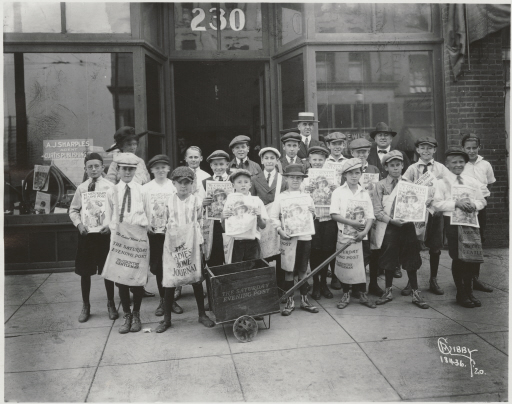
The photograph collections of the Joel E. Ferris Research Library and Archives provide a rich array of regional images of Spokane and the Inland Northwest. From railroads to rivers, school children to strawberry pickers, and bicycle shops to brickyards, the photograph collection offers some of the most intriguing and entertaining images from the history of this region.
Photographic prints from this collection may be purchased through the Research Library and Archives.

African American Community Chatcolet Lake
Chatcolet Lake in northern Idaho
The Bass Club owned a cabin at Chatcolet Lake in northern Idaho, where members of Spokane’s African American community gathered to enjoy fishing. Photographer Wally Hagin extensively documented many aspects of the African American community during the 1930s and 40s including the African American community participating in many local events and activities. Hagin also photographed the members of the amateur baseball team playing for their local Elks Lodge chapter.
Photographer: Wally Hagin, circa 1935, L97-56.1.
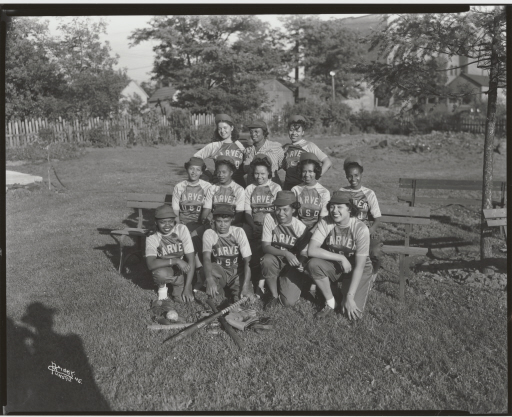
African American Community
Women’s Baseball Team
African American Women's baseball team “Carver.” Standing left to right: Miss Houston; Mrs. Rosa Malone director of U. S. O.; Olga Armstrong. Seated left to right: Jessie Wellington Sarto; Freddie Mae Huff Petri; Pauline Lake; Mary Hill McFarlin; Ruth McHenry. Kneeling left to right: Irma Brown; Ruby White; ?; Barbara Armstrong. 1945.
Photographer: Libby Photography Studio, 1945, L87-1.44590-45.

Amusement Rides at Natatorium Park
Natatorium Park offered fun times and many forms of entertainment. Spokane’s “Coney Island” included amusement rides, traveling shows, sporting events, and public dances Founded in 1889 as Twickenham Park, Nat Park became a destination point for young and old alike. For many, the amusement rides like the flying planes and roller coaster were a part of growing up in Spokane. Although the park closed permanently in 1968, the Looff Carousel was relocated to Riverfront Park.
Photographer: Unknown, circa 1920s, L86-284.
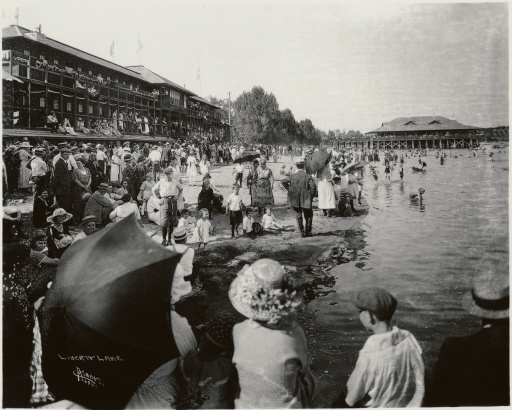
Beachfront at Liberty Lake
Liberty Lake beaches have been a local favorite for recreation and leisure since the late 1890s. A boardwalk and a band pavilion bordered the lakeside, and a resort hotel and dance hall were built on pilings over the water. An electric train made travel convenient between Spokane and the lake, allowing folks from the city to cool from the summer heat.
Photographer: Charles A. Libby, 1923, L87-1.23843-23.

Bicycle Racers
These four young men were practicing in Spokane’s first park, Coeur d’Alene Park, for a race scheduled at Corbin Park. The fairgrounds at Corbin Park often hosted athletic competitions, racing events, and county fairs. Bicycling found a loyal following in Spokane as a competitive sport, an outdoor leisure activity, and practical and inexpensive transportation.
Photographer: Unknown, circa 1900, L83-59.1.
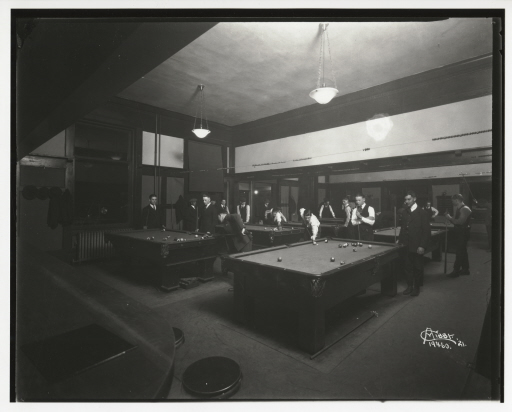
Billiard Room at the YMCA
The YMCA of Spokane was established in 1884 and originally located on the corner of First and Lincoln. Initially, the YMCA served boys and men, and as well as the Spokane’s labor community. The downtown YMCA hosted many forms of indoor and outdoor recreation, including swimming, a hostel, cafeteria, youth activities, and a billiard hall.
Photographer: Charles A. Libby, 1921, L87-1.19460-21.
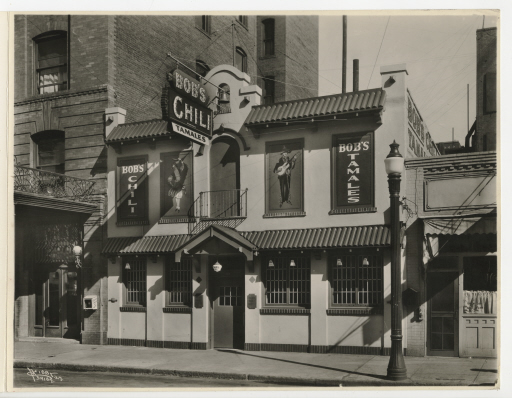
Bob’s Chili Parlor
Bob’s Chili & Tamales Parlor was popular in the 1920s, establishing Spokane's reputation for good food and fine restaurants.
Photographer: Charles A. Libby, 1927, L87-1.34107-27.

Bozanta Tavern
The Bozanta Tavern (designed by architect Kirtland Kelsey Cutter) was built in the early 1900s on Hayden Lake. The name was changed to the Hayden Lake Country Club in the early 1920s. Hayden Lake and Bozanta Tavern were popular destination points on the electric railway that ran from Spokane to Coeur d’Alene.
Photographer: Unknown, circa 1915, L94-57.1.

Campbell House
Architect Kirtland Cutter designed Campbell House in the Tudor Revival architectural style. Mansions at the turn of the century often included a carriage house and a private coachman. The Campbell family’s coachman, Joseph Gladding, drove the family carriage to the front of the house.
Photographer: Unknown, circa 1900, L88-454.

Campbell House Museum
Campbell House, a well-known Spokane landmark and museum, was built in 1898. Spokane architect Kirtland K. Cutter designed the house for the Amasa B. Campbell family, who donated the home to the Eastern Washington State Historical Society in 1925. Art and history exhibits filled the rooms until 1959 when the Cheney Cowles Memorial Museum opened next door. In 1960, restoration began, and the house now operates as a historic house museum.
Photographer: Tom Chestnut, circa 1935, L95-12.193.
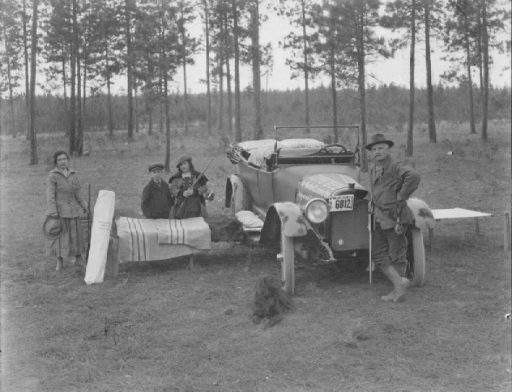
Car Camping
Inland Northwest outdoor enthusiasts soon utilized the automobile, and outdoor motoring fueled the growth of both the National Park and Good Roads movements. By World War I, Spokane sported a large number of cars, including this General Motors touring car that featured an “Indispensable Auto Bed—for summer or winter use.”
Photographer: Ingalls, 1918, L83-113.16.

Checkers Game
The Royal Riblet mansion, located on Myrtle Peak overlooking the Spokane River, was promoted as the most electrified home in the United States when it was constructed in 1924. Access to the Riblet Mansion was by electric tram across the Spokane River, and the house featured electric heat and electric refrigeration, extensive outdoor game courts, and a pool. Royal Riblet was an inventor, tramway engineer, and bicycler racer. The Riblet mansion and property are now the Arbor Crest Winery.
Photographer: Frank W. Guilbert, circa 1925, L95-111.105.
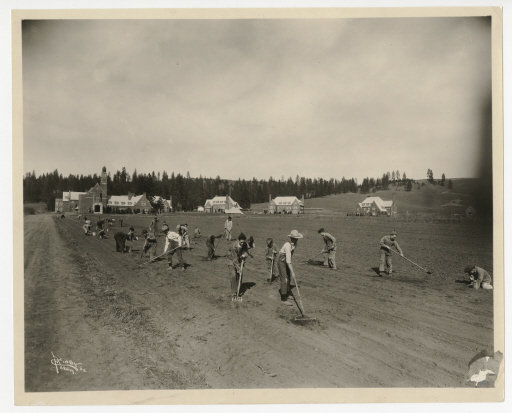
Children at the Hutton Settlement
Levi Hutton, who was raised an orphan, used profits from his Idaho silver mining ventures to build the Hutton Settlement. Dedicated to his wife, May Arkwright Hutton, also an orphan, the Hutton Settlement was constructed in the Spokane Valley in 1918. The Settlement provided housing and education for orphans and children in need. Working in the fields was part of daily chores and responsibilities for children residing there.
Photographer: Charles A. Libby, 1925, L87-1.28617-25.

Children Berry Picking
Fruits and vegetables thrived in the fertile soil of the Spokane Valley. Strawberry picking remains a popular family activity during berry season. Many local farms, particularly in the community of Green Bluff northeast of Spokane, still open their berry fields to the public, and many local farmers and berry pickers still sell their products at local farmers’ markets.
Photographer: Frank Palmer, 1908, L84-327.687.
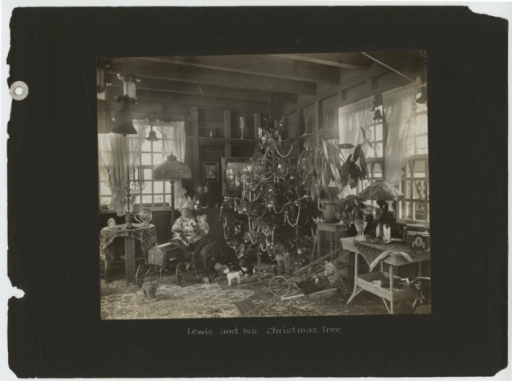
Christmas at the Louis Davenports
Louis Davenport’s Eighth Avenue home, located approximately where Sacred Heart Hospital now stands, was a prominent Spokane landmark. The home illustrated Spokane's taste for old European-style architecture and natural landscape. Louis’s son Lewis sits on a new pedal car in the family living room at Christmas in 1912.
Photographer: Unknown, 1912, L88-404.19.2.48.
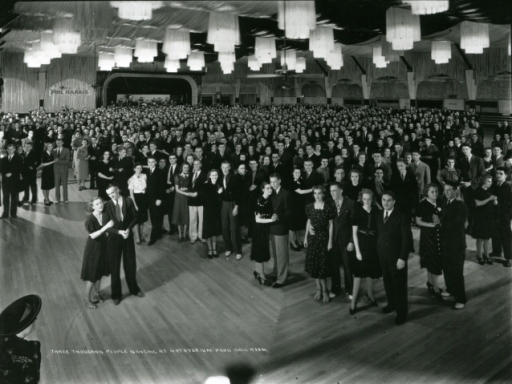
Dance Pavilion at Natatorium Park
Dances held by civic groups and clubs provided popular entertainment in Spokane. This large crowd filled the Natatorium Park dance pavilion to dance to Phil Harris’ Big Band. Phil Harris was the musical director for Jack Benny’s radio programs. Crowds of several thousand were common when the park attracted popular big band names, and the music was often broadcast on live radio.
Photographer: Charles A. Libby, 1938, L87-1.14711-38.
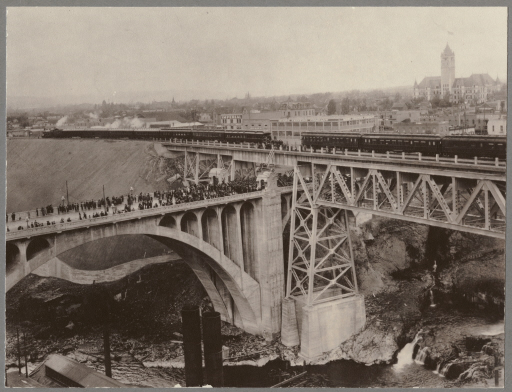
Dedication of Union Pacific Viaduct
After the construction of Northern Pacific rail lines through Spokane Falls in 1881, the community became a major transportation hub. Soon thereafter, trains traveled on elevated tracks through the heart of the city. On September 15, 1914, officials drove a “golden spike,” completing the Union Pacific Railroad track over the concrete span of the Monroe Street Bridge. These tracks were removed to complete improvements for the 1974 Expo World’s Fair.
Photographer: Unknown, 1914, L84-197.18.
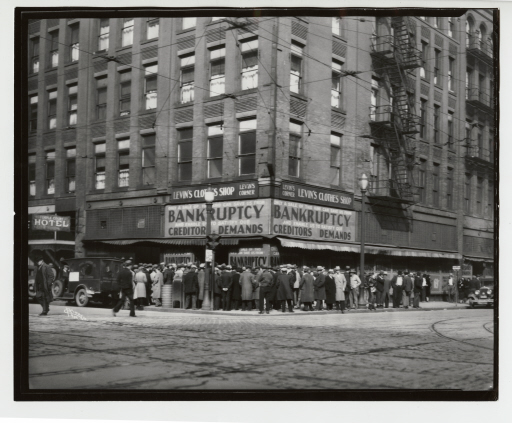
Depression Era Bankruptcy Sale
The market value of precious metals and agricultural products significantly impacted Spokane’s economy, and the Great Depression left many unemployed. Many Spokane businesses failed or were forced to sell goods at very low prices. Sales like the one pictured at Levin's Clothes Shop on West Riverside were a common sight.
Photographer: Charles A. Libby, 1932, L87-1.919-32.

Downriver Golf Course
Spokane’s climate and scenic landscape provided many locations for outdoor sports like golf. The Downriver Golf Course opened in 1926 at its current location next to the Spokane River and Riverside State Park. Tournaments for men and women were regular summer activities for residents and visitors. Golf continues as a popular pastime and tourist attraction in the Inland Northwest. Downriver’s Hole 12 is Hole 3 today.
Photographer: Frank W. Guilbert, circa 1926, L95-111.426.
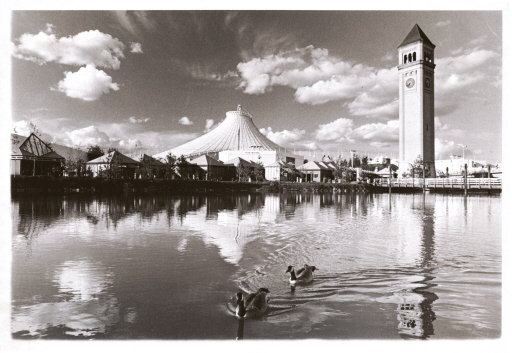
Expo ’74 World’s Fair
The 1974 Expo World’s Fair revived interest in preserving and beautifying the landscape surrounding the falls of the Spokane River and provided for the construction of the Spokane Opera House and surrounding riverfront walkways. Spokane, the smallest city to ever host a World’s Fair, used the event to promote ideas about environmentalism and resource sustainability, and brought national and international attention to Spokane and the Inland Northwest. The Fair's slogan was “Tomorrow's New Environment.”
Photographer: Expo Collection, 1974, L2002-33.36.
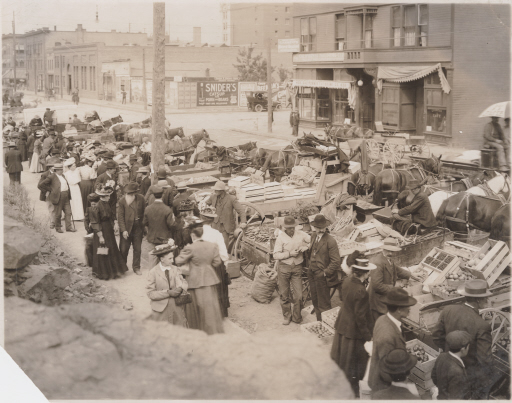
Farmers’ Market
Farmers’ markets were common in Spokane. New roads brought fresh fruits and vegetables each season. The tradition continues today.
Photographer: Unknown, 1908, L90-208.2.

Finch House
The Finch residence, located in Browne’s Addition, was constructed in 1898. Kirtland Cutter designed the home in the Colonial Revival architectural style. John Finch was Amasa B. Campbell's business partner in the lucrative Coeur d’Alene mining district. A Standard Fuel & Ice deliveryman holds a block of ice waiting delivery to Finch residence.
Photographer: Unknown, circa 1915, L93-87.17.
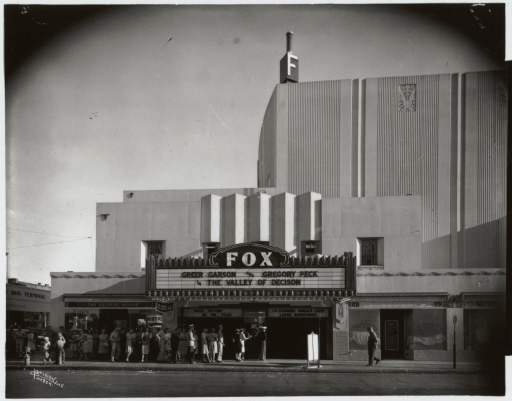
Fox Theatre
Spokane’s Fox Theatre is one of the last Art Deco styled theaters surviving in the United States today. Built in 1931 at a cost of one million dollars, the Fox Theatre was designed for traveling vaudeville shows as well as movies. It was the first large building in Spokane to feature air-conditioning. The Spokane Symphony owns the building and has embarked on an immense project to restore the building to its original beauty.
Photographer: Charles A. Libby, 1945, L87-1.44834-45.
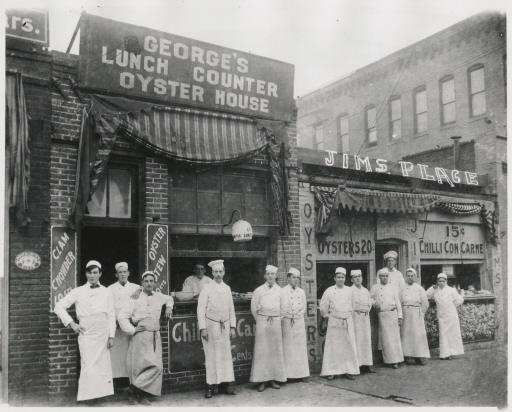
George’s Lunch Counter
Restaurants flourished next to each other in Spokane, providing a wide variety of choice for food fare. George’s Lunch Counter and Oyster House and Jim’s Place fed factory workers and business people.
Photographer: Charles A. Libby, 1921, L87-1.19156-21A.
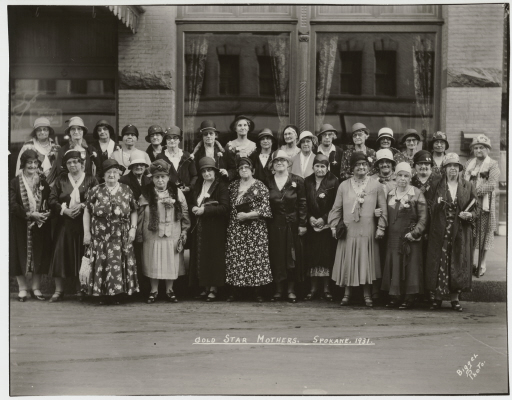
Gold Star Mothers
Grace Darling Seibold formed the Gold Star Mothers organization in 1928. Chapters were started across the nation in most major cities including Spokane. The organization’s purpose was to promote patriotism and the American ideals that young soldiers fought for. The Gold Star Mothers organization continues today, actively supports U.S. military veterans, and works to promote American idealism and patriotic values.
Photographer: Biggel, 1931, L94-57.54.

Grand Coulee Dam
1935
Grand Coulee Dam was the largest construction project initiated during the depression, and for a time was the largest dam in the world. The project benefited the Inland Northwest by providing jobs for concrete and jackhammer workers, revenue for the local economy, and the long-term benefit of inexpensive hydroelectric power. The availability of inexpensive electricity attracted industrial development by companies like Kaiser Aluminum, and providing sustained employment and economic growth for Spokane. President Franklin D. Roosevelt presided over the groundbreaking ceremonies in 1934.
Photographer: Charles A. Libby, 1935, L87-1.7765-35.
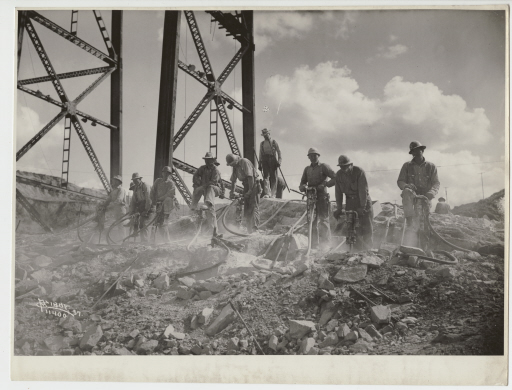
Grand Coulee Dam
1937
Grand Coulee Dam was the largest construction project initiated during the depression, and for a time was the largest dam in the world. The project benefited the Inland Northwest by providing jobs for concrete and jackhammer workers, revenue for the local economy, and the long-term benefit of inexpensive hydroelectric power. The availability of inexpensive electricity attracted industrial development by companies like Kaiser Aluminum, and providing sustained employment and economic growth for Spokane. President Franklin D. Roosevelt presided over the groundbreaking ceremonies in 1934.
Photographer: Charles A. Libby, 1937, L87-1.11400-37.

Great Northern Railroad Wreck
Occasional train wrecks were commonplace for cities that depended on rail transportation. In 1903, a Great Northern freight train derailed in Spokane. Through the 1920s, most train cars were made of wood, and local lumber mill workers were usually called upon cut apart the damaged train cars.
Photographer: Charles A. Libby, 1903, L87-1.304.
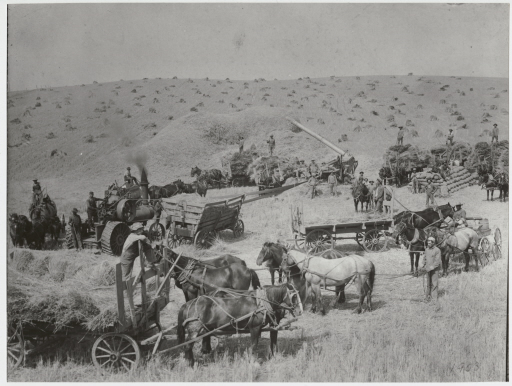
Harvesting Crew
Steam power greatly improved the Inland Northwest's annual grain harvest. Horse-drawn wagons transported loads of wheat shocks to a threshing center. There, steam engines used long leather belts to operate threshing machines. Men fed wheat manually into each thresher to separate wheat seeds from stalk and chaff. The steam engines burned waste wheat stalks as fuel, producing power equivalent to an additional 20–30 horses. As production increased, Spokane emerged as a trade center for exporting or milling these agricultural products.
Photographer: Unknown, circa 1903, L94-57.21.
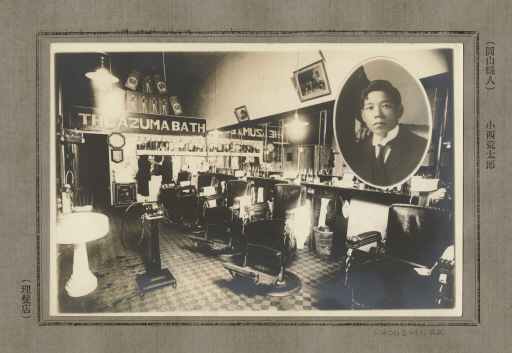
Japanese American Businesses
Barber Shop
Spokane supported a substantial Japanese American community and many of these residents owned small businesses. Most were located together near Front Avenue (now Spokane Falls Boulevard). Japanese residents were not allowed to own property, but many found ingenious ways to earn a living, sometimes combining a variety of trade skills or offering different types of services under one roof. An “Issei Japanese Business Album” was created in 1913 to show how immigrants from Japan were prospering in Spokane.
Ryosuki Akashi, 1913, L2003-11.22.
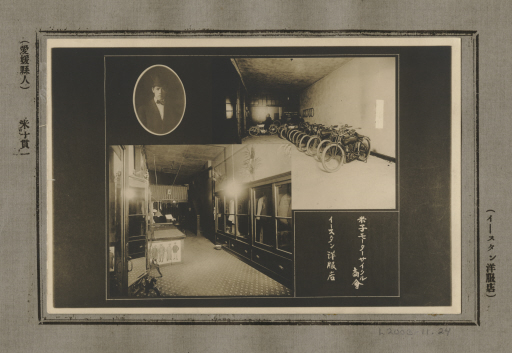
Japanese American Businesses
Motorcycle Shop
Spokane supported a substantial Japanese American community and many of these residents owned small businesses. Most were located together near Front Avenue (now Spokane Falls Boulevard). Japanese residents were not allowed to own property, but many found ingenious ways to earn a living, sometimes combining a variety of trade skills or offering different types of services under one roof. An “Issei Japanese Business Album” was created in 1913 to show how immigrants from Japan were prospering in Spokane.
Photographer: Ryosuki Akashi, 1913, L2003-11.24.
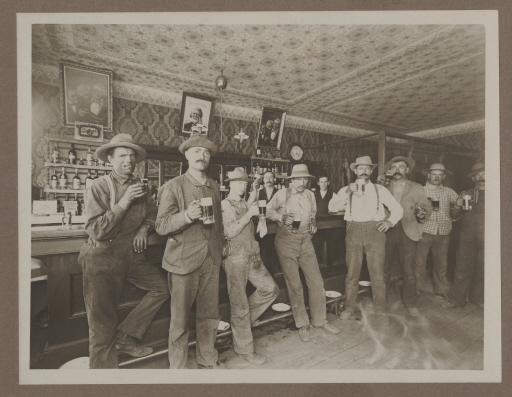
Local Saloon
Taverns and saloons attracted many locals after a long day of work. Earnings from mining and logging camps supported much of their business. These establishments became centers for social and community building, as well as relaxation and entertainment. Spokane had five large breweries in the early 1900s, and most saloons were owned and operated by the brewing companies.
Photographer: Elite Photo Co., circa 1910, L95-97.133.
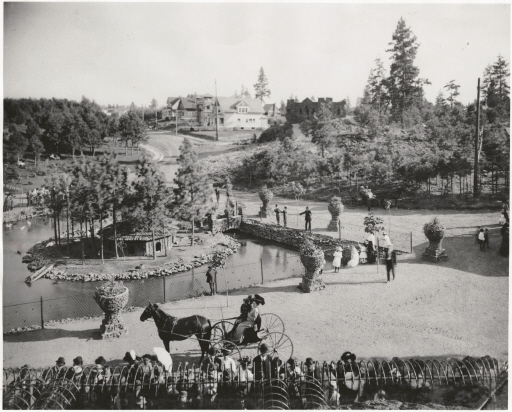
Manito Park Zoo
Manito Park formed the core of a 1904 residential development on Spokane’s South Hill. Soon after, the city’s new Board of Park Commissioners hired the Olmsted Brothers to create a comprehensive plan for Spokane parks, playgrounds, and parkways. At the time, Manito Park included a duck pond, tennis courts, lawn-bowling green, the Duncan gardens and greenhouse, and new paths for walking and picnicking. Another major feature was the zoo, located near where the Japanese Garden is today.
Photographer: Unknown, 1905, L94-57.50.

Marie Antoinette Ballroom
Davenport Hotel ballrooms were popular locations for weddings, dances, and celebrations. The Davenport Hotel opened in 1914 at a cost of three million dollars. The Marie Antoinette Room was a great location for dance parties and a young Helen Campbell danced during the September opening of the hotel.
Photographer: Charles A. Libby, 1914, L87-265.

Medical Lake Sanitarium
The legend of Medical Lake’s healing waters began in 1877. The Medical Lake Sanatorium was built in 1888, resting on the shore of the lake. The original building was eventually torn down and the Eastern Washington State Hospital is located there now.
Photographer: Unknown, 1908, L86-57.11.

Miss Spokane Dresses
Clothing and garment manufacturing provided labor jobs in Spokane, primarily for women. Edwards Clothing Manufacturing, located on North Division Street, made clothing for a variety of labels. The women in this photograph were sewing dresses for Miss Spokane, Inc.
Photographer: Charles A. Libby, 1929, L94-24.169.

National Indian Congress
The National Indian Congress sponsored meetings in Spokane in 1925 and 1926. Tribes from the surrounding region and other parts of the country discussed treaty issues, conducted ceremonies, and created unity within the Indian communities. Many events occurred at the Glover Field encampment located near the foot of the Monroe Street Bridge in the Peaceful Valley neighborhood.
Photographer: Charles A. Libby, 1926, L87-1.31551-26.

Needlework Class
The Crescent clothing and retail store was a landmark business in the Spokane community. Founded in 1889, the Crescent continued as a prominent retail store until it closed in 1991 when purchased by Frederick & Nelson. The Crescent hosted many events and offered classes in sewing and clothing crafts like the cross-stitching.
Photographer: Unknown, circa 1920s, L85-79.77.
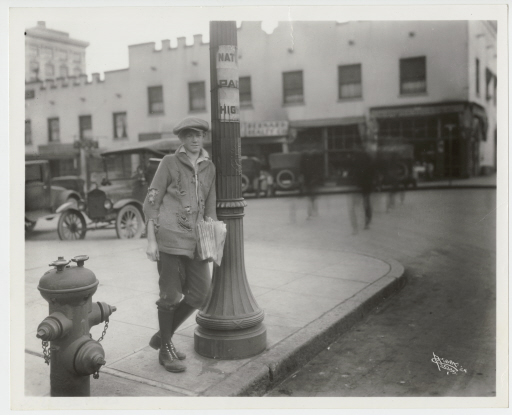
Newsboy
Newsboys were a common sight on Spokane street corners and in front of buildings during the 1920s. To help sell papers, newsboys shouted out headlines to get the attention of people walking or driving nearby. Spokane had several newspapers in the 1920s, the Spokane Chronicle, Spokane Press, and the Spokesman-Review.
Photographer: Charles A. Libby, 1924, L87-1.25335-24.

Newsboys
Many young people found work with local newspaper and magazine distributors to earn extra spending money. These youngsters were employees of A.J. Sharples, agent for Curtis Publishing Co., who sold popular periodicals like Ladies Home Journal and The Saturday Evening Post. The Saturday Evening Post was the largest selling magazine in the country, and was well known for illustrations by Norman Rockwell.
Photographer: Charles A. Libby, 1920, L87-1.18436-20.

North Division Street
Expansion of the “Y” in 1932, where Division Street and U.S. 195 and 395 split, helped connect the surrounding agricultural areas and opened new property for commercial and residential development. The AAA automobile club (notice the AAA sticker on the back of the vehicle) provided benefits to area motorists as early as 1902, and promoted membership by sponsoring the auto races at Meadows Racetrack outside Georgetown, Washington in 1905.
Photographer: Frank W. Guilbert, 1932, L95-111.97.

Northwest Airlines
A Northwest Airlines passenger plane awaits takeoff at Felt’s Field, Spokane’s first airport. The airstrip provided municipal airport services during the 1930s and 1940s and provided a base for the Washington Air National Guard. Felts Field operates today as an airstrip and a designated historic site.
Photographer: Charles A. Libby, 1939, L87-1.16141-39.
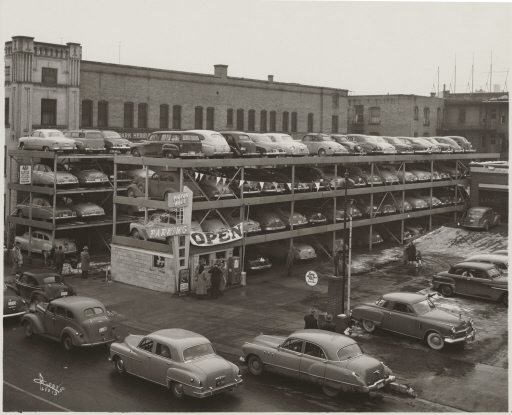
Pigeon Hole Parking
Cars, and a need for parking, impacted the look of downtown Spokane. Limited space led to creative solutions like the Pigeon Hole Parking Garage. Using lots that were too narrow for regular structures, Pigeon Hole Parking garages used a hydraulic lift similar to an elevator. The company eventually was bought by Otis Elevator Company, but disappeared from the market due to high maintenance costs for the lift equipment.
Photographer: Charles A. Libby, 1950, L87-1.65213-50.
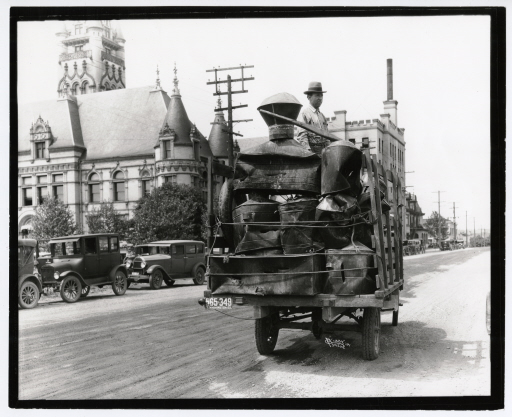
Prohibition Enforcement
Some Spokane residents actively promoted prohibition laws aimed at controlling the growth and profits of saloons and breweries. In 1915, the State of Washington passed a bill banning the consumption and sale of liquor beginning January 1, 1916. National Prohibition followed in 1920 and lasted until 1933. This photograph documents a truck loaded with distillery equipment confiscated by Spokane law enforcement agents in front of the Spokane County Courthouse.
Photographer: Charles A. Libby, 1929, L87-1.39509-29.

Riverside and Monroe
The intersection of Riverside and Monroe streets, so near the Monroe Street crossing of the Spokane River, was an important location in downtown Spokane. Next to the landmark Spokesman-Review building was the Crescent Department Store, the only survivor of the Great Spokane Fire of 1889. A Standard Oil gas station contrasts with the trolley tracks visible on the streets.
Photographer: Charles A. Libby, 1924, L87-1.25883-24.

Salvation Army Donut Line
During the Great Depression, many people migrated to Spokane in search of work and lodging. Community outreach by The Salvation Army provided food and shelter. The Salvation Army sold “Famous Doughnuts” as a way of raising funds, and was known for its doughnut and coffee lines at its shelters and hostels.
Photographer: Unknown, circa 1930, L94-40.42.

Salvation Army Promotional Photo
The Salvation Army used this photograph for promotional purposes, advertising food, shelter, and aid during the difficult days of the Great Depression.
Photographer: Lacey, 1933, L93-66.294.
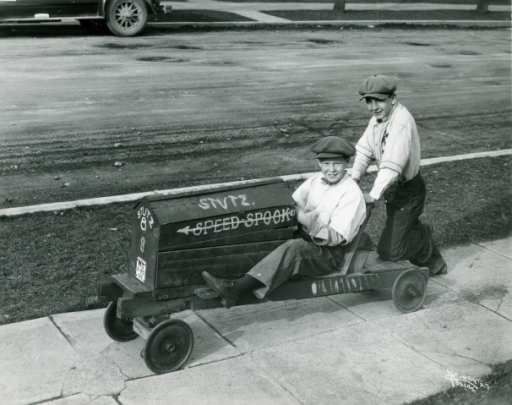
Soapbox Racer
Car culture boomed in Spokane during the 1920s. Children participated by building soapbox racers and racing them in competitions. This soapbox racer was named for Harry Clayton Stutz, founder of the Stutz Motor Car Company and famous for creating competition race cars.
Photographer: Charles A. Libby, 1927, L94-10.168.
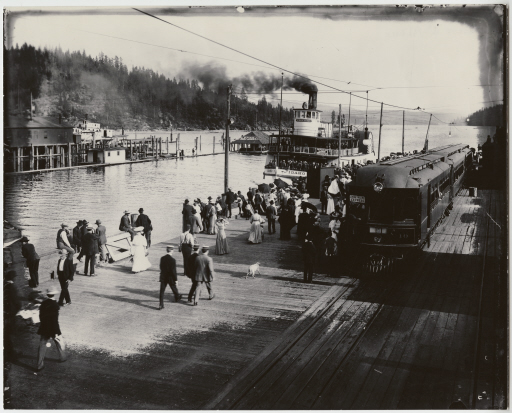
Spokane & Inland Empire Railroad Dock
Spokane residents’ love of nearby recreation spurred development of electric rail lines from Spokane through Liberty Lake to Coeur d’Alene, Idaho. From Coeur d’Alene, the steamer “Idaho,” and many others, crossed the lake to access more remote areas. Swimming, picnicking, and camping were favorite activities.
Photographer: T. W. Tolman, 1907, L86-219.155.

Spokane and Coeur d’Alene Indians
The Plateau Indians are a large, interconnected community of tribes located between the Cascade and Rocky Mountain ranges. They share similar traditions and language base, and gathered for traditional feasts and celebrations. Members of the Coeur d’Alene and Spokane tribes were photographed in Worley, Idaho at a donation feast for Curley Jim (last on the left).
Photographer: Frank Palmer, 1917, L84-327.796.

Spokane County Courthouse
Regional architect W. A. Ritchie’s designs were selected in 1895 for the Spokane County Courthouse. His design ideas were based on castles located in the Loire Valley of France, styled in the 16th Century French Renaissance tradition. After heated debate, planners chose a site for the new courthouse on the north side of the river, hoping to unite the north and south of Spokane. Washington Brick, Lime and Manufacturing Company supplied many of the decorative building materials for the structure.
Photographer: Charles A. Libby, 1923, L87-1.23970-23.

Spokane Eagles Amateur Baseball Team
In the early 1900s, Spokane was well known as a city of clubs and organizations, many of which sponsored amateur sport teams. Social and civic organizations like the Elks and the Eagles lodges often competed in local tournaments. The Fraternal Order of the Eagles Lodge No.2 sponsored the Spokane Eagles’ baseball team.
Photographer: Plummer Photography, circa 1920, L85-326.
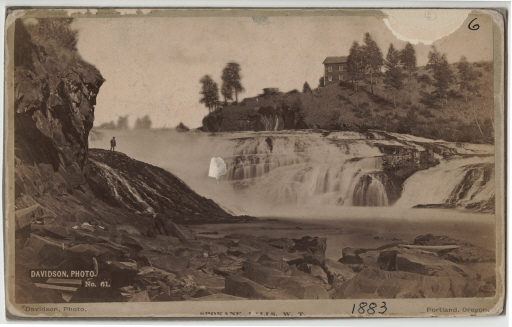
Spokane Falls, Washington Territory
The falls of the Spokane River were sacred to the Spokane Indians and important to early settlers. Their beauty and potential for harnessing waterpower was economically attractive and James Glover, affectionately known as the “father of Spokane,” enticed Frederick Post to come to Spokane Falls and build a flour mill on Glover’s original land claim. Fredrick Post's mill was located where the Washington Water Power/Avista power plant now stands on Post Street.
Photographer: I. G. Davidson, 1883. L86-1050.
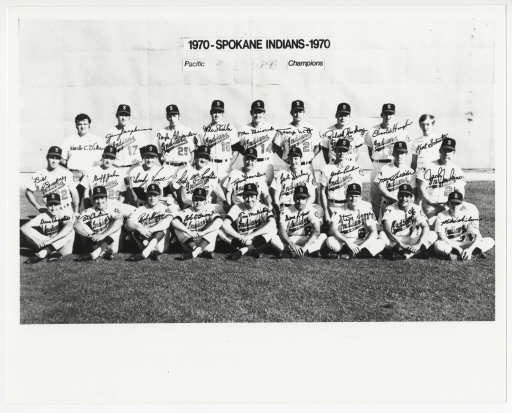
Spokane Indians Baseball Team—1970
Baseball was a favorite past time, and the Spokane Indians still enjoy a loyal following. The 1970 team won the Pacific League Championship and was considered one of the best AAA teams in the country. Many of the players played in the major leagues and manager Tommy Lasorda was a crowd favorite in Spokane and later with the Los Angeles Dodgers.
Photographer: Unknown, 1970, L94-40.69.
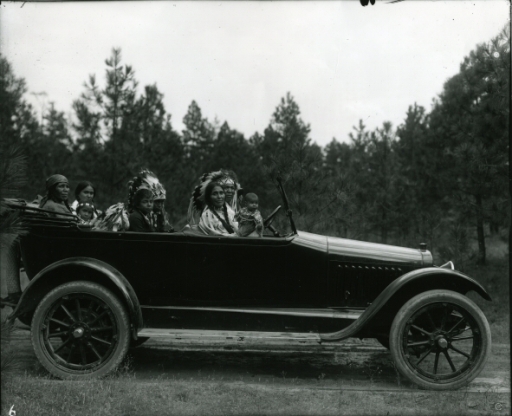
Sunday Drive
Automobiles were new to the Inland Northwest at the turn of the century. Coeur d’Alene tribal elder and farmer Philip Wildshoe and his family were photographed in his new Chalmers automobile. Wildshoe was a prosperous farmer and was very proud to be photographed in his new Chalmers touring car. Wildshoe was said to have given rides to all those who asked, and continued to drive the car into the early 1950s.
Photographer: Frank Palmer?, 1910, L84-327.725.
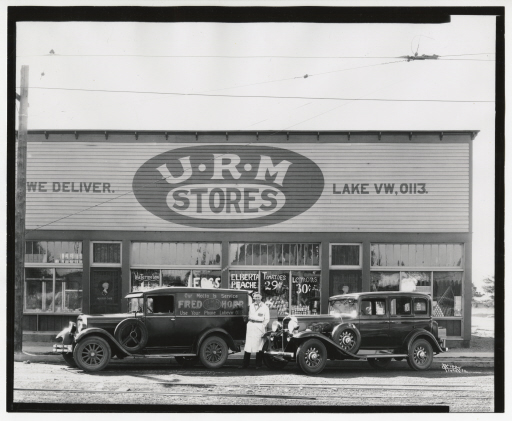
URM Stores
Spokane’s economy suffered during the depression, but the United Retail Merchants Stores (URM) was one business that survived. URM Stores started in 1921 as a wholesale cooperative for local grocers, restaurants, and hotel food services, and continued as a prominent presence in Spokane's business and civic community.
Photographer: Charles A. Libby, 1932, L87-1.1490-32.
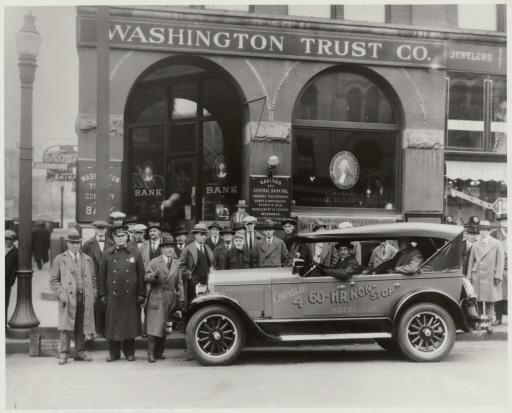
Washington Trust Bank
The Washington Trust Bank is one of the oldest banks in the Northwest. Established in 1902, the Washington Trust has been a key financial institution in the growth of Spokane and the Inland Northwest. The 1925 Model 52 Touring car in front of the Riverside Avenue location was promoting a “60 hour non-stop motor run.” The photographer's camera case was located on the ground on the left of the spectators.
Photographer: Charles A. Libby, 1925, L87-1.30020-25.

Washington Water Power Control Room
This room was the central control room for Washington Water Power/Avista’s network for electricity distribution. The diagrams on the wall represent over 200 miles of service area. At the time of this photograph, all electrical power monitoring and switching was performed without the use of computers. The futuristic look of the control room was typical of 1950s industrial design.
Photographer: John Keith, 1952, L95-122.10.
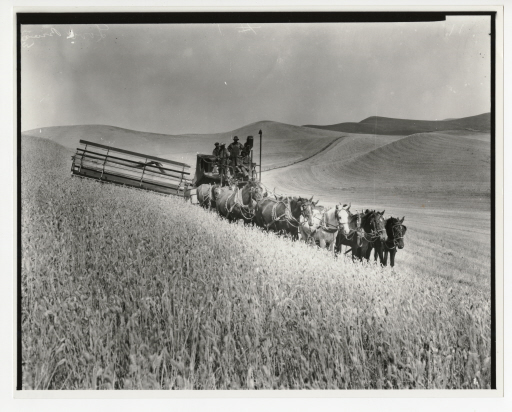
Wheat Harvest
Combines merged several wheat-harvesting functions into one machine, and soon replaced the traditional harvest by threshing crews and steam-operated machines. Large wheels cut the wheat stalks, while threshing machines located behind the drivers separated wheat seeds from chaff. Large teams of horses pulled the earliest combines across the rolling hills of the Inland Northwest. Gas-powered tractors eventually replaced the horses. In addition to simplifying the harvest process, combines greatly reduced the labor costs associated with annual wheat harvest.
Photographer: T. W. Tolman, 1908, L86-219.193.